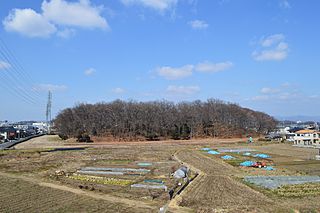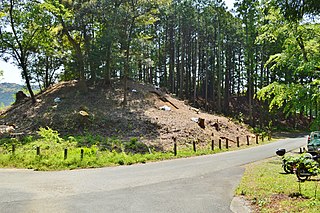
The Takarazuka Kofun (宝塚古墳) is a group of Kofun period burial mounds located in the Takarazuka neighborhood of the city of Matsusaka, Mie Prefecture in the Kansai region of Japan. It was designated a National Historic Site of Japan in 1932.

The Hodota Kofun Cluster (保渡田古墳群) is a group of three Kofun period burial mounds located in what is now the city of Takasaki, Gunma Prefecture in the northern Kantō region of Japan. It was designated a National Historic Site of Japan in 1985.

The Shiroishi Inariyama Kofun (白石稲荷山古墳) is a Kofun period burial mound located in the Shiroishi neighborhood of the city of Fujioka, Gunma Prefecture in the northern Kantō region of Japan. It was designated a National Historic Site of Japan in 1993. It is one of several kofun in the Shiroishi Kofun cluster. The National Historic designation was expanded in the year 2009 to cover two nearby kofun: the Junitenzuka Kofun (十二天塚古墳) and the Junitenkitazuka Kofun (十二天塚北古墳).

Sengenyama Kofun (浅間山古墳) is a Kofun period burial mound located in the Kuraganomachi neighborhood the city of Takasaki, Gunma Prefecture in the northern Kantō region of Japan. It was designated a National Historic Site of Japan in 1927. It is the second largest kofun in Gunma Prefecture after the Ōta Tenjinyama Kofun (Ōta), and third in the Kantō region after the Ōta Tenjinyama Kofun and the Funazukayama Kofun. It is estimated to have been built around the end of the 4th century and the beginning of the 5th century and is part of a group of 13 tumuli which were concentrated in the vicinity, forming the Kuragano kofun cluster.

Ōta Tenjinyama Kofun (太田天神山古墳) is a Kofun period burial mound located in the Uchigashimacho neighborhood of the city of Ōta, Gunma Prefecture in the northern Kantō region of Japan. It was designated a National Historic Site of Japan in 1941. It is the largest kofun in Gunma Prefecture and the 28th largest in the country. It is the only kofun with a length in excess of 200 meters in eastern Japan.. It is also sometimes referred to as the Dantaiyama Kofun (男体山古墳).

The Kōmyōsan Kofun (光明山古墳) is a Kofun period burial mound located in the Yamahigashi neighborhood of Tenryū-ku, Hamamatsu, Shizuoka Prefecture in the Chūbu region of Japan. The tumulus was designated a National Historic Site of Japan in 2020.

The Akeae Kofun (明合古墳) is a kofun burial mound located in the Ano neighborhood of the city of Tsu, Mie Prefecture in the Kansai region of Japan. It was designated a National Historic Site of Japan in 1952.

The Mukaiyama Kofun (向山古墳) is a kofun burial mound located in between the Ōno and the Ureshino-Ueno neighborhoods of the city of Matsusaka, Mie Prefecture in the Kansai region of Japan. It was designated a National Historic Site of Japan in 1975.

The Kōjinyama Kofun (荒神山古墳) is a Kofun period burial mound located between the Hinatsu and Kiyosaki neighborhoods of the city of Hikone Shiga Prefecture in the Kansai region of Japan. The tumulus was designated a National Historic Site of Japan in 2011.

The Chausuyama Kofun (茶臼山古墳) is a Kofun period burial mound located in the Akibadai neighborhood of Ōtsu, Shiga in the Kansai region of Japan. The tumulus was designated a National Historic Site of Japan in 1921. With a total length of 122 meters, it is the third largest kofun in Shiga Prefecture.

Mayuyama Kofun (摩湯山古墳) is a Kofun period keyhole-shaped burial mound, located in the Mayu neighborhood of the city of Kishiwada, Osaka in the Kansai region of Japan. The tumulus was designated a National Historic Site of Japan in 1956, with the area under protection expanded in 2010.

Maruyama Kofun (丸山古墳) is a Kofun period keyhole-shaped burial mound, located in the Jizodō neighborhood of the city of Kaizuka, Osaka in the Kansai region of Japan. The tumulus was designated a National Historic Site of Japan in 1956. It is also called the Jizo-dō Maruyama Kofun (地蔵堂丸山古墳)

The Makino Kurumazuka Kofun (牧野車塚古墳) is a Kofun period keyhole-shaped burial mound, located in the Ogura Higashimachi neighborhood of the city of Hirakata, Osaka in the Kansai region of Japan. The tumulus was designated a National Historic Site of Japan in 1922 with the area under protection expanded in 1980.

The Shinmeiyama Kofun (神明山古墳) is a Kofun period burial mound, located in the Tangochomiya neighborhood of the city of Kyōtango, Kyoto in the Kansai region of Japan. The tumulus was designated a National Historic Site of Japan in 1923.

The Ebisuyama Kofun (蛭子山古墳) is a Kofun period burial mound, located in the Yosano neighborhood of the town of Yosano, Kyoto in the Kansai region of Japan. The tumulus was designated a National Historic Site of Japan in 1930.

The Tamaoka Kofun cluster (玉丘古墳群) is a group of seven kofun burial mounds located in the Shinya, Tamaoka and Tamano neighborhoods of the city of Kaisai, Hyōgo Prefecture, in the Kansai region of Japan. The Tamaoka Kofun was individually designated a National Historic Site in 1943, with the others added in 1978 and the area under protection expanded in 1997.

The Danjōzuka Kofun (壇場山古墳) refers to a group of kofun burial mounds located in the Mikuninochō-Kokubunji neighborhood of the city of Himeji, Hyōgo Prefecture, in the Kansai region of Japan. Four tumuli were collectively designated a National Historic Site in 1921.

The Shibunomaruyama Kofun (渋野丸山古墳) is a Kofun period burial mound, located in the Mitsuiwa hamlet of the Shibuno neighborhood of the city of Tokushima on the island of Shikoku in Japan. It was designated a National Historic Site of Japan in 2009, with the area under protection expanded in 2012

The Tomita Chausuyama Kofun (富田茶臼山古墳) is a kofun burial mound located in the Ōkawamachi Tomidanaka neighborhood of the city of Sanuki, Kagawa Prefecture, on the island of Shikoku of Japan. The tumulus was designated a National Historic Site in 1993. It is the largest burial mound in the Shikoku region, and is estimated to have been built around the middle of the 5th century.

Tsukuriyama Kofun (造山古墳) is a cluster of Kofun period burial mounds located in the Shinjōshita neighborhood of Kita-ku, Okayama, Okayama Prefecture, in the San'yō region of Japan. The cluster was designated a National Historic Site of Japan in 1921. The main Tsukuriyama Kofun is the largest burial mound in Okayama Prefecture and the fourth largest in Japan.























